Pop quiz: what do websites and public buildings have in common?
If you said "sometimes confusing signage," you're not wrong. But what they should have in common is website accessibility for everyone.
We’re talking about a fundamental human right here, the ability for everyone to use the internet, regardless of physical or cognitive ability. That includes browsing, shopping, booking a dentist appointment, or learning how to juggle flaming torches (we do not endorse this).
Let’s dig deep into why WCAG compliance isn’t just some corporate checkbox. It's about making your website usable for all. Yes, all. (Even that cousin who still uses Internet Explorer.) Businesses can achieve this with the right custom web development services.
What Web Accessibility Really Means
Web accessibility standards are the practice of designing and developing websites that people with disabilities can use. That includes users who:
- Are blind or visually impaired
- Are deaf or hard of hearing
- Have motor impairments
- Have cognitive or learning disabilities
It also includes those in temporary or situational scenarios. Holding a baby in one arm and using a phone with the other? That’s situational disability. Recovering from surgery and unable to use a mouse? That’s temporary.
Accessibility is about making sure everyone can use your site, and following accessible web design principles helps you get there.
Many companies rely on enterprise software development solutions to integrate accessibility from the ground up.
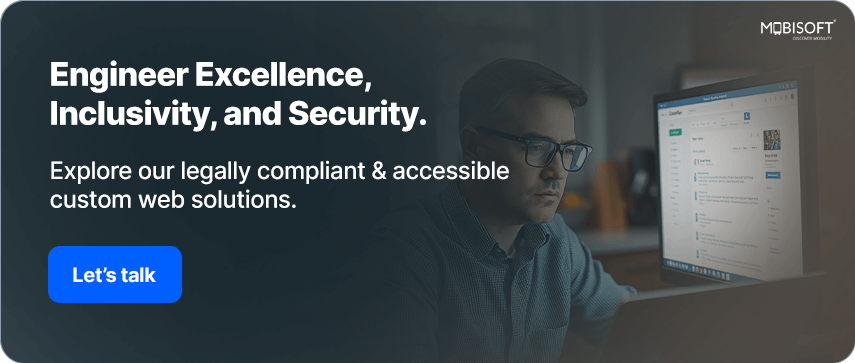
Who Benefits from Accessible Websites?
Let’s get this straight: accessible website benefits extend far beyond people with disabilities.
Here’s a list of folks who will love you for having an accessible site:
- Older adults with declining vision, hearing, or motor control
- People in noisy environments (they’ll thank you for video captions)
- Users with slow internet connections
- Mobile users trying to navigate with their thumbs and patience
Real-life scenario: Ever tried clicking a tiny checkbox on a mobile screen in the back of a bumpy cab ride? Now imagine doing that with limited motor skills every single day.
Inclusive design for websites means thoughtful design. You future-proof your website while showing that you care.
Partnering with the right digital transformation consulting experts helps scale accessibility for long-term impact.
The Legal Side: Avoiding Digital Courtrooms
No one wants to be sued because their contact form can't be used with a keyboard.
Unfortunately, lawsuits related to inaccessible websites are on the rise. In the U.S., the ADA website accessibility law has been interpreted to apply to websites. Other countries have their own website accessibility standards, including:
- UK: Equality Act 2010
- EU: European Accessibility Act
- India: Rights of Persons with Disabilities Act
- Canada: AODA (Accessibility for Ontarians with Disabilities Act)
Let’s break this down:
- Big corporations? Obvious targets.
- Small businesses? Increasingly being pulled in too.
Accessibility is about legal armor. Skip it, and you’re risking fines, lawsuits, and bad PR.
Still think it’s overkill? Domino’s Pizza went to the Supreme Court over its inaccessible website. Yes, pizza got sued.
A proactive approach with accessible UI/UX design services can help mitigate such risks.
Accessibility and Business: Why It Pays
Let's talk about money, because your CFO is now listening.
Reach More Customers
Over a billion people globally have some form of disability. If your site isn’t accessible, you’re telling a huge market: “Go away.”
Would you put up a “No Entry” sign on your shop’s front door? No? Then why block customers online with poor website accessibility features?
Boost Brand Loyalty
When you design for everyone, you signal that you care. People notice. And they stick around.
Fun fact: 90% of customers say they’re more loyal to brands that show social responsibility.
Increase Conversions
Accessible web design often improves usability across the board. Cleaner layouts, better contrast, and readable fonts help everyone convert.
Reduce Customer Support Load
When your site is easy to use, fewer people get frustrated and reach out for help. That means fewer angry emails that begin with “WHY IS THIS SO HARD?”
The impact of UX on conversion rates proves accessibility is directly linked to business growth.
SEO and Accessibility: Best Friends Forever
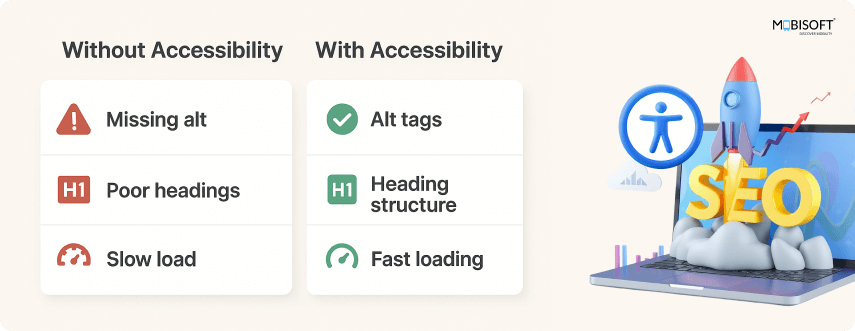
If SEO accessibility and inclusivity were a buddy comedy, they’d be an unstoppable duo.
Google also loves accessible sites
- Alt text helps screen readers and Google image search
- Clear headings help readers and help bots understand the structure
- Descriptive links make sense to screen readers and Google crawlers
It’s about thoughtful content.
Think of it this way: If a robot can navigate your site, and a screen reader can too, you’re winning.
Bonus: Fast load times, mobile-friendliness, and website accessibility best practices like keyboard navigation all help with your SEO rankings. For deeper insights, explore how accessibility in UX design shapes both SEO and usability.
The Most Common Accessibility Pitfalls
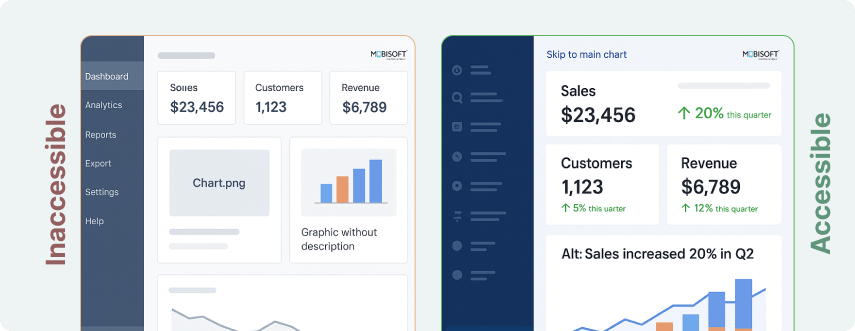
You might think your website is just fine, but here are some problems we see all the time:
- Images with no alt text: Screen readers can’t describe what they can’t “see.”
- Color-only cues: Red text to signal error? Great - unless you’re color blind. Only color is used to indicate the meaning of status, which will be a huge problem for color blind people.
- Low contrast text: White on pale gray? Gorgeous. Also unreadable. Low contrast texts are not only a problem for visually impaired people but also make life difficult for older adults.
- No keyboard support: Some users don’t use mice. Don’t make them suffer.
- Inaccessible forms: No labels, confusing fields, and no clear instructions? That’s a mess.
Avoid these, and you’re already ahead of most of the internet by following web accessibility best practices. Learn how to start balancing design and usability without compromising accessibility.
How to Make Your Website Accessible (Without Losing Your Mind)
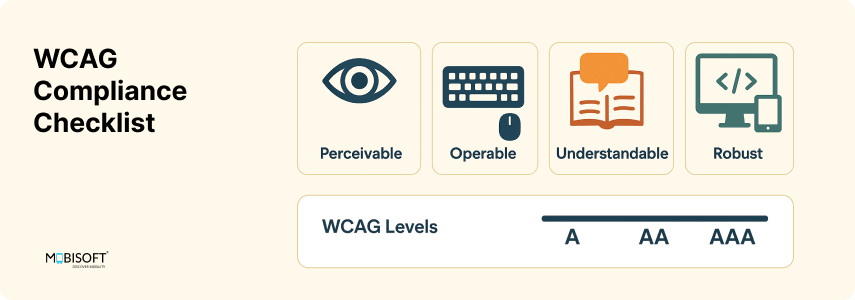
Here’s how to get started with website accessibility solutions:
Step 1: Follow WCAG Guidelines
That’s the Web Content Accessibility Guidelines. Sounds dull, but it’s gold. Aim for at least WCAG 2.1 Level AA.
Step 2: Use Semantic HTML
Don’t use <div> for everything. Use proper tags:
- <button> instead of <div onclick="">
- <label> for form fields
- <h1> to <h6> for proper headings
Step 3: Add Alt Text to All Images
Make sure your images have clear, descriptive alt text. Avoid vague stuff like “image123.jpg.”
Bad alt: "dog."
Good alt: "Golden Retriever puppy playing with a tennis ball in a garden."
Step 4: Design for Keyboard Users
All interactive elements should be reachable using just a keyboard. Use the Tab key and see if you can reach all buttons, forms, and links.
Step 5: Use ARIA Wisely
ARIA (Accessible Rich Internet Applications) attributes help add meaning to elements. If you're not sure, stick with semantic HTML first.
Step 6: Ensure Contrast
Use tools like WebAIM or Stark to check that your color combinations are readable by all.
Step 7: Caption Your Videos
Always. Even your “funny office moments” blooper reel.
Tools That Make Your Life Easier
Let tech do some heavy lifting. Here are a few lifesavers:
- WAVE (by WebAIM): Shows accessibility issues right on your site.
- axe DevTools: Chrome extension for in-browser testing.
- NVDA: Free screen reader for Windows.
- VoiceOver: Built into macOS and iOS.
- Lighthouse: Google’s accessibility testing tool inside Chrome DevTools.
Some advanced businesses also explore website accessibility AI solutions and AI platforms that automatically scan and fix compliance issues.
Accessibility Testing: Yes, You Have to Do It
Don't assume your site works; test it.
Manual Testing Checklist:
- Navigate your entire site using only the keyboard.
- Check screen reader compatibility.
- Resize text up to 200%. Does your layout still work?
- Turn off CSS. Is your content still logical?
Bonus: Involve Real Users
You can read 100 checklists, but real users will catch issues you never imagined. Partner with accessibility testers or organizations.
Real-World Examples (a.k.a. Success Stories)
Bank of America
They redesigned their website with accessibility in mind and saw a major boost in customer satisfaction, particularly among older adults.
BBC
Their accessibility guidelines became industry gold. And guess what? Their content reaches millions, including people with vision or hearing impairments, without a hitch.
Virgin America
They overhauled their booking system and won awards for accessibility. Oh, and conversion rates went up.
Accessibility Myths That Need to Die

“Only blind people benefit from accessibility.”
Nope. Color blindness, dyslexia, hearing loss, motor issues, and all kinds of users need an inclusive design for websites. Accessibility and WCAG compliance ensure digital experiences work for everyone.
“It’s too expensive.”
It’s way cheaper to build accessibility from the start than to retrofit your broken site later. A proactive website accessibility solution saves both time and resources in the long run.
“Accessible websites are ugly.”
Have you seen Apple’s site? Or GOV.UK? Clean, beautiful, and accessible. This proves accessible web design not only meets website accessibility standards but also creates modern, user-friendly interfaces.
“We’ll do it later.”
Later usually means never. And “never” can get you sued, ignored by customers, or penalized by search engines. Following web accessibility best practices upfront protects your brand.
Final Thoughts: Build Better for Everyone
Accessibility is a bonus. It’s the foundation of a modern, user-friendly, successful website.
Yes, it takes effort. It might challenge some of your current design habits. But it’s worth it. Making your site accessible not only keeps you ADA website accessibility compliant but also improves SEO, boosts trust, and drives business growth.
And here’s the best part: website accessibility makes the experience better for everyone. That includes Grandma on her iPad, your friend with carpal tunnel, a sleep-deprived dad browsing one-handed, a marketing intern with slow Wi-Fi, and, yes, you.
Because accessibility is for all of us.


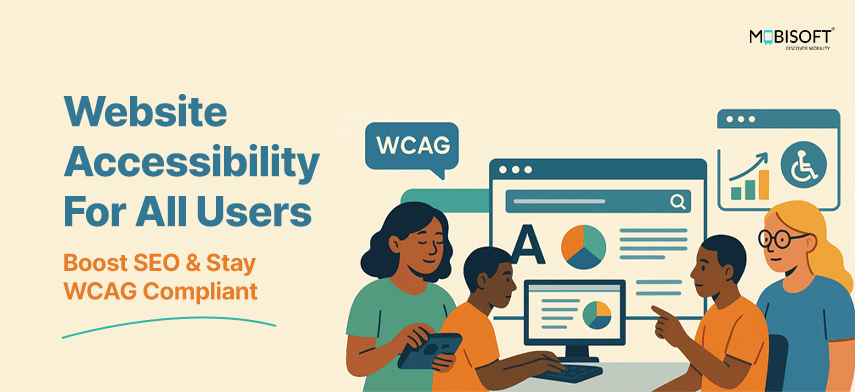


 June 30, 2025
June 30, 2025


